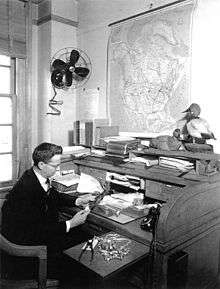Frederick Charles Lincoln
| Frederick C. Lincoln | |
|---|---|
 Lincoln at his desk. From the U.S. National Archives and the U.S. Bird Banding Laboratory. | |
| Born |
May 5, 1892 Denver, Colorado |
| Died |
September 16, 1960 (aged 68) Washington, D.C. |
| Resting place | Arlington National Cemetery |
| Nationality | United States |
| Fields | Ornithology |
| Known for | Lincoln index, flyway concept |
Frederick Charles Lincoln (5 May 1892 – 16 September 1960) was an American ornithologist.
Early life and family
Lincoln was born on 5 May 1892 in Denver, Colorado.[1]
Career
As a teenager working at the Colorado Museum of Natural History in 1909, Lincoln learned to prepare specimens from Alexander Wetmore (who was then a student working at the museum) and L. J. Hershey, the museum's Curator of Ornithology.[1][2] Lincoln's interest in birds continued to develop, and he eventually went on to succeed Hershey as curator in 1913, a post which he held until 1920.[1][2] He took time out in 1918–1919 to serve as pigeon expert in the U.S. Army Signal Corps.[2] The professional relationship with Wetmore would continue: the two scientists took field trips together in Washington and Hispaniola and co-wrote eight publications.[1]
In 1920, Lincoln joined the U.S. Bureau of Biological Survey (at the time, a unit of the United States Department of Agriculture, and now part of the United States Fish and Wildlife Service [3]) and was given the task of organizing and expanding the bird banding program nationwide.[2] The Migratory Bird Treaty Act of 1918 had established federal responsibility for migratory birds; the result was that the North American Bird Banding Program took the place of earlier smaller-scale efforts by individuals and the short-lived American Bird Banding Association. During the period of his tenure, 1920–1946, Lincoln was highly influential: he improved methods for trapping and banding, developed record-keeping procedures, recruited banders, fostered international cooperation, and promoted banding as a tool for research and wildlife management.[1][2] He proposed a means to estimate the continent-wide population size of a bird species, using reports from hunters and counting "returns" (birds killed that are wearing bands); this metric became known as the Lincoln index.[1] He developed the flyway concept, a key idea in the management and regulation of hunting of migratory birds.[1]
Lincoln joined the American Ornithologists' Union in 1910 and was elected a Fellow of the organization in 1934.[1][4]
Later life and death
Lincoln died on 16 September 1960 in Washington, D.C. and was buried in Arlington National Cemetery.[1]
Legacy and recognition
Lincoln received an honorary Doctor of Science degree from the University of Colorado in 1956; in 1957, the Department of the Interior recognized him with its Distinguished Service Award.[1]
Selected publications
- Lincoln, Frederick C. (April–June 1921). "The History and Purposes of Bird Banding". The Auk. 38 (2): 217–228. doi:10.2307/4073884. Retrieved 21 May 2013.
- Lincoln, Frederick C. (April 1921). Instructions for Bird Banding. Circular. 170. Washington, DC: United States Department of Agriculture. Retrieved 21 May 2013.
- Lincoln, Frederick C.; Baldwin, Samuel Prentiss (November 1929). Manual for Bird Banders. Miscellaneous Publication. 58. Washington, DC: United States Department of Agriculture. Retrieved 3 June 2013.
- Lincoln, Frederick C. (May 1930). Calculating Waterfowl Abundance on the Basis of Banding Returns. Circular. 118. Washington, DC: United States Department of Agriculture. Retrieved 21 May 2013.
- Phillips, John C.; Lincoln, Frederick C. (1930). American Waterfowl. Boston, MA: Houghton Mifflin Company.
- Lincoln, Frederick C. (January 1935). The Waterfowl Flyways of North America. Circular. 342. Washington, DC: United States Department of Agriculture. doi:10.5962/bhl.title.64010. Retrieved 21 May 2013.
- Lincoln, Frederick C. (October 1935). The Migration of North American Birds. Circular. 363. Washington, DC: United States Department of Agriculture. doi:10.5962/bhl.title.64016. Retrieved 21 May 2013.
- Lincoln, Frederick C.; Fuertes, Louis Agassiz (1939). The Migration of American Birds. New York, NY: Doubleday, Doran & Company.
- Gabrielson, Ira N.; Lincoln, Frederick C. (1959). Birds of Alaska. Harrisburg, PA: The Stackpole Company.
References
- 1 2 3 4 5 6 7 8 9 10 Gabrielson (1962).
- 1 2 3 4 5 Tautin (2005).
- ↑ "Who We Are". U.S. Fish and Wildlife Service. Retrieved 4 June 2013.
- ↑ Palmer, T. S. (January–March 1935). "The Fifty-Second Stated Meeting of the American Ornithologists' Union". The Auk. 52 (1): 53–63. doi:10.2307/4077107. Retrieved 24 May 2013.
Bibliography
- Gabrielson, Ira N. (July–September 1962). "Obituary". The Auk. 79 (3): 495–499. doi:10.2307/4082843. Retrieved 2 April 2013.
- Tautin, John (2005). "Frederick C. Lincoln and the Formation of the North American Bird Banding Program" (PDF). In Ralph, C. John; Rich, Terrell D. Bird Conservation Implementation and Integration in the Americas. Third International Partners in Flight Conference. 2002 March 20–24; Asilomar, California. Albany, California: U.S. Department of Agriculture, Forest Service, Pacific Southwest Research Station. pp. 813–814. Gen. Tech. Rep. GTR-PSW-191. Retrieved 21 May 2012.